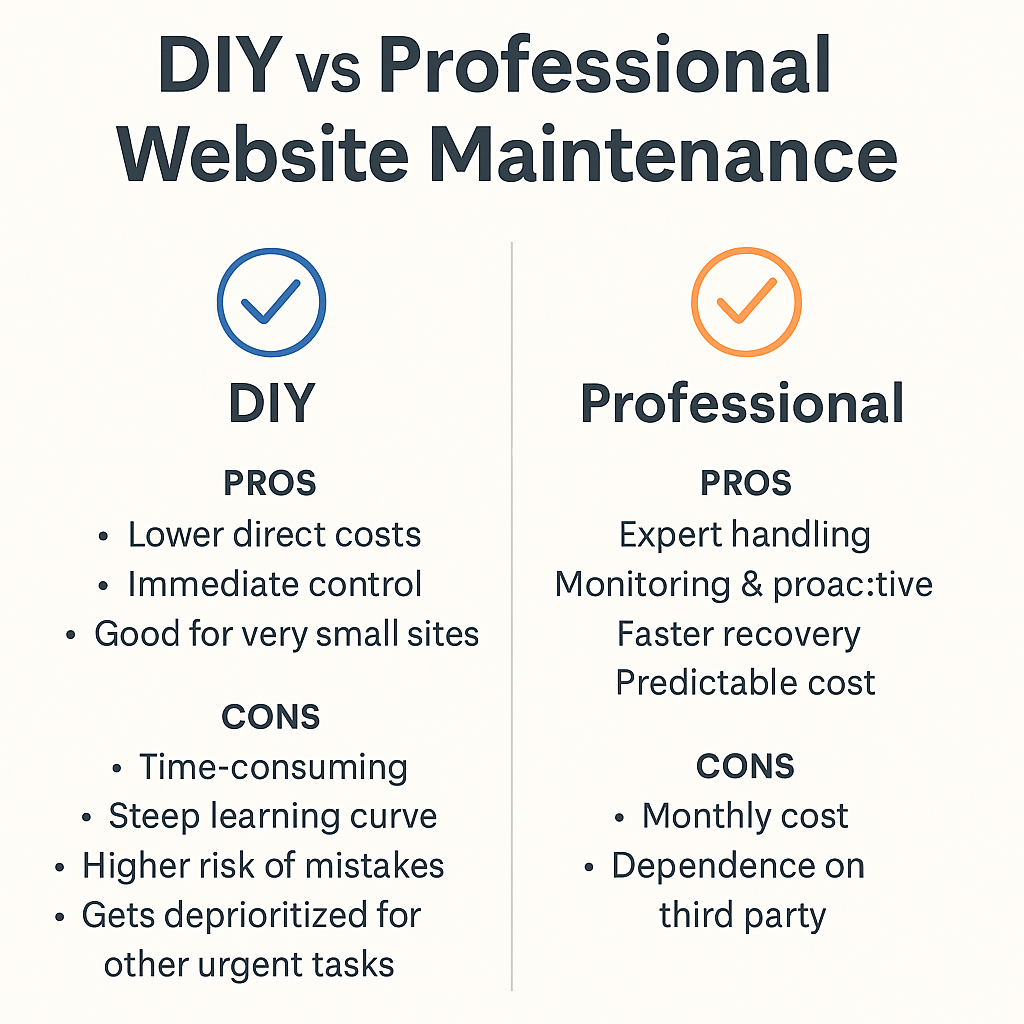When it comes to maintaining a website, many business owners start out with good intentions. They tell themselves: “I’ll handle the updates, keep the plugins current, and run backups myself.”
But the reality is different. Website care almost always gets deprioritized for other urgent tasks like serving customers, answering calls, or putting out the latest business fire. Days turn into weeks, updates pile up, and before long, the site is running on outdated software that’s one step away from breaking or being hacked.
The question isn’t whether your site needs maintenance (it does). The real question is: should you do it yourself, or hire a professional? Let’s break down both options.

The Case for DIY Website Maintenance
There are situations where maintaining your website yourself can make sense — especially if you’re just starting out or running a very small, low-stakes site.
The Pros of DIY
- Lower direct costs. You don’t pay a monthly fee, just your time.
- Immediate control. You decide when to run updates or make changes.
- Good for small sites. Personal blogs, hobby sites, or basic brochure-style websites can sometimes get by with DIY upkeep.
The Cons of DIY
- Time-consuming. Updates, testing, backups, and troubleshooting can eat up hours every month.
- Steep learning curve. Unless you’re comfortable with WordPress, databases, and error logs, expect frustration.
- Higher risk of mistakes. A plugin update can conflict with another, crashing your site. Fixing that may not be simple.
- Gets deprioritized. Most owners mean well but push maintenance to “later.” Updates pile up until something breaks.
- Reactive, not proactive. DIY often means waiting for problems instead of preventing them.
If your site is small, low-traffic, and you’re comfortable tinkering with technology, DIY might be a viable choice. But for most business-critical websites, the risks outweigh the savings.
The Case for Professional Maintenance
Professional website care is about more than just running updates. It’s about having someone proactively monitoring, optimizing, and securing your site so you can focus on running your business.
The Pros of Professional Maintenance
- Expert handling. Professionals know how to update safely, test compatibility, and prevent conflicts.
- Proactive monitoring. Instead of waiting for a crash, issues are spotted early and fixed before they escalate.
- Faster recovery. If something does go wrong, professionals can restore from a backup quickly and minimize downtime.
- Predictable costs. A monthly care plan is easier to budget for than the unpredictable cost of emergency repairs.
- Saves you time. Your hours are better spent serving customers, closing deals, and growing your business.
- Expert on Call. You always have a trusted expert who is familiar with your site, on call when an emergency arises.
The Cons of Professional Maintenance
- Monthly cost. You’re paying a regular fee for peace of mind.
- Dependence on a third party. You’ll need to trust someone else with your site’s well-being.
For most businesses, those trade-offs are well worth it.
The Hidden Costs of Downtime
The biggest mistake business owners make is assuming they’re “saving money” by maintaining their own sites. The reality: the hidden costs of downtime can wipe out years of savings in just a few hours.
Industry studies put the average cost of downtime anywhere from $137 per minute for small businesses to $300,000+ per hour for larger companies. Even if your site isn’t an e-commerce giant, think about the real impact:
- Missed sales during outages.
- Leads lost when forms don’t work.
- Customer trust eroded by “Not Secure” warnings.
- SEO rankings slipping when your site is unstable.
- Hours of your own time wasted troubleshooting instead of selling.
Saving a few hundred dollars a year by skipping professional maintenance doesn’t look like much of a win compared to a single day of lost leads or orders.
When DIY Might Work
There are scenarios where DIY maintenance is acceptable:
- Personal blogs or hobby sites. Low traffic and low stakes mean you can afford downtime.
- Very small static sites. If your site rarely changes and has no forms or e-commerce, the risks are minimal.
- Technically savvy owners. If you know your way around WordPress, databases, and security plugins, you might be comfortable managing it yourself.
For most businesses, though, these situations don’t apply.
When Professional Care Is Essential
If your website is critical to your business, professional maintenance isn’t optional — it’s insurance.
- E-commerce websites. Every minute of downtime equals lost sales.
- Membership or subscription sites. Recurring revenue depends on consistent functionality.
- Association websites. When member access, renewals, or resources depend on the site, uptime is non-negotiable.
- Lead generation sites. Broken forms mean missed opportunities.
- Businesses where credibility matters. A hacked or broken site damages reputation instantly.
- Owners with limited time. If your time is better spent closing deals than updating plugins, outsource the work.
These sites are too valuable — and the risks too high — to gamble with DIY maintenance.
Choose Peace of Mind
DIY website maintenance can work in very specific cases, but for most businesses, it’s a false economy. The cost of professional care is predictable and small compared to the cost of lost leads, sales, or credibility when something goes wrong.
If your website is more than a digital business card — if it’s a sales channel, a member hub, or a credibility builder — professional maintenance is the smart choice.
At iGo Sales and Marketing, our Website Care Plans give you peace of mind that your site is always updated, backed up, and performing at its best. We handle the behind-the-scenes work so you can focus on running your business.
Don’t wait until something breaks. Choose proactive care today and keep your website working for you.

